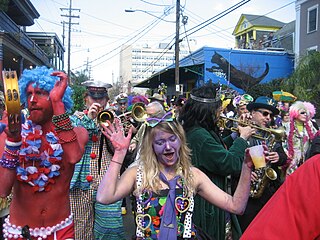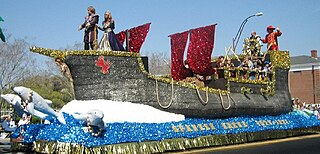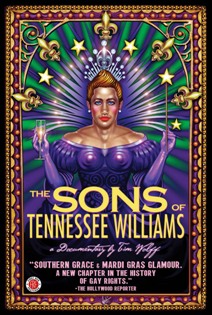Related Research Articles

Mardi Gras, or Fat Tuesday, refers to events of the Carnival celebration, beginning on or after the Christian feasts of the Epiphany and culminating on the day before Ash Wednesday, which is known as Shrove Tuesday. Mardi Gras is French for "Fat Tuesday", reflecting the practice of the last night of eating rich, fatty foods before the ritual Lenten sacrifices and fasting of the Lenten season.

A krewe is a social organization that puts on a parade or ball for the Carnival season. The term is best known for its association with Mardi Gras celebrations in New Orleans, but is also used in other Carnival celebrations around the Gulf of Mexico, such as the Gasparilla Pirate Festival in Tampa, Florida, Springtime Tallahassee, and Krewe of Amalee in DeLand, Fl with the Mardi Gras on Mainstreet Parade as well as in La Crosse, Wisconsin and at the Saint Paul Winter Carnival.
The Mistick Krewe of Comus, founded in 1856, is a New Orleans, Louisiana, Carnival krewe. It is the oldest continuous organization of New Orleans Mardi Gras festivities.
Rex is a New Orleans Carnival Krewe which stages one of the city's most celebrated parades on Mardi Gras Day. Rex is Latin for "King", and Rex reigns as "The King of Carnival".

The holiday of Mardi Gras is celebrated in all of Louisiana, including the city of New Orleans. Celebrations are concentrated for about two weeks before and through Shrove Tuesday, the day before Ash Wednesday. Usually there is one major parade each day ; many days have several large parades. The largest and most elaborate parades take place the last five days of the Mardi Gras season. In the final week, many events occur throughout New Orleans and surrounding communities, including parades and balls.
The Krewe of OAK is a small neighborhood New Orleans Mardi Gras krewe and parade held in the Carrollton neighborhood of New Orleans, Louisiana. The parade starts and ends on Oak Street, presumably the origin of the name, although members say that OAK stands for "Outrageous And Kinky".
Carnival Memphis, is a series of parties and festivities staged annually since 1931 in Memphis, Tennessee by the centralized Carnival Memphis Association and its member krewes during the month of June. Carnival salutes various aspects of Memphis and its industries, and is reigned over by the current year's secretly selected King, Queen, and Royal Court of Carnival.

Lundi Gras is a relatively recently popularized name for a series of Shrove Monday events taking place during the Mardi Gras. It includes the tradition of Rex, king of the New Orleans carnival, and Zulu King arriving by boat. This began in 1874, but the term Lundi Gras was not widely applied until 1987 when the arrival was brought back as part of a series of river-related events under the name of "Lundi Gras". Lundi Gras was the creation of journalist Errol Laborde. The event was staged with the cooperation of Riverwalk Marketplace and its then marketing director Carol Thistle Lentz. The events are detailed in Laborde's book, Krewe: The Early New Orleans Carnival from Comus to Zulu.
The Strikers Independent Society is a mystic society founded in 1843 in Mobile, Alabama and participated in Carnival during New Year's Eve and New Year's Day celebrations. It is the oldest remaining mystic society in America but no longer hosts an annual parade.

Krewe of Bacchus is a New Orleans Mardi Gras super krewe.

Mardi Gras is the annual Carnival celebration in Mobile, Alabama. It is the oldest annual Carnival celebration in the United States, started by Frenchman Nicholas Langlois in 1703 when Mobile was the capital of Louisiana. This was fifteen years before New Orleans was founded, although today their celebrations are much more widely known for all the current traditions such as masked balls, parades, floats and throws were first created there. From Mobile being the first capital of French Louisiana (1702), the festival began as a French Catholic tradition. Mardi Gras in Mobile has now evolved into a mainstream multi-week celebration across the spectrum of cultures in Mobile, becoming school holidays for the final Monday and Tuesday, regardless of religious affiliation.

A mystic society is a Mardi Gras social organization in Mobile, Alabama, that presents parades and/or balls for the enjoyment of its members, guests, and the public. The New Orleans Krewe is patterned after Mobile's Mystics. The societies have been based in class, economic and racial groups. Mobile's parading mystic societies build colorful Carnival floats and create costumes around each year's themes.

Al "Carnival Time" Johnson is an American singer and piano player best known for the Mardi Gras song "Carnival Time".

Mardi Gras in the United States is not observed nationally across the country, largely due to the country’s Protestant and Anglo roots. Mardi Gras and Carnival are mostly Catholic holidays, while the United States has a Protestant majority population. However, a number of cities and regions in the U.S. have notable Mardi Gras or Carnival celebrations. Most of these places trace their Mardi Gras celebrations to French, Spanish, and other Catholic colonial influences on the settlements over their history. The earliest Carnival celebration in North America occurred at a place on the west bank of the Mississippi river about 60 miles downriver from where New Orleans is today; this Mardi Gras on the 3rd of March 1699 and in honor of this holiday, Pierre Le Moyne, Sieur d'Iberville, a 38-year-old French Canadian, named the spot Point du Mardi Gras near Fort Jackson. The earliest organized Carnival celebrations occurred in Mobile, Biloxi, New Orleans, and Pensacola, which have each developed separate traditions. In addition, modern activities generally vary from city to city across the U.S.

The Krewe du Vieux is a New Orleans Mardi Gras krewe more fully known as the Krewe du Vieux Carré.
The Krewe of Yuga was the first gay Carnival krewe in New Orleans, founded in 1958 by members of the gay community. Costumed parties to view the Krewe of Carrollton parade in Uptown were transformed into a krewe with a Queen reigning over the festivities, a ball captain, and sometimes a King. Emulating the format established by traditional Carnival krewes and their courts, such as the Krewe of Proteus and the Mystick Krewe of Comus, the Krewe of Yuga also declared itself a royal krewe with its Yuga Regina. The queen was always a gay man in drag and these celebrations mark a significant point in the history of the city. The Krewe is referenced in the 2010 documentary The Sons of Tennessee Williams.

The Krewe of Cleopatra is an all female krewe and social organization.
In 1875, the Louisiana State Legislature declared Mardi Gras a legal holiday in the state of Louisiana. The holiday is observed on the day before Ash Wednesday.

The Sons of Tennessee Williams is a 2010 American historical documentary film produced and directed by Tim Wolff. The film spans five decades documenting the gay carnival balls in New Orleans, and the efforts of the gay community to celebrate Mardi Gras, without being discriminated against and without fear of police intervention. It stars Charles Maddox, Tommy Dietsch, George Roth, Don Stratton, Jimmy Keyes, Mike Moreau, John Henry Bogie, Albert Carey, Bianca Del Rio and additional krewe club members that share their memories through interviews and archival footage. The film had its world premiere at Frameline Film Festival on June 26, 2010. It was released to theaters on October 7, 2011. Wolff said the title of the film came about as a twist on The Daughters of the American Revolution; he considers Williams a hero and inspiration, and said he was "the most famous out American at the time, telling the story of gay men to a much larger audience".
References
- ↑ Smith, Howard Philips, Unveiling the Muse: The Lost History of Gay Carnival in New Orleans, 2017, (Jackson: University Press of Mississippi, pp. xi-xvii)
- ↑ Foster, Mary (14 February 2010). "Gay Mardi Gras krewes unique part of Carnival". The Times. Shreveport, Louisiana. AP. p. 6B. Retrieved 20 May 2019.
- ↑ Hudgins, Gregory; Campbell, Allyson (27 January 2013). "Belated greetings from the Caribbean and beyond". The News-Star. Monroe, Louisiana. p. 2D. Retrieved 20 May 2019.
- ↑ Smith, Howard Philips, Unveiling the Muse: The Lost History of Gay Carnival in New Orleans, 2017, (Jackson: University Press of Mississippi, pp. 113-151)
- 1 2 Elist, Jasmine (13 October 2011). "Taking on highs, lows of gay krewes". The Los Angeles Times. p. D3. Retrieved 20 May 2019.
- ↑ Messer, Kate (21 January 2015). "Mardi Gras 2015: Mardi Gai". The Austin Chronicle . Retrieved 21 May 2019.
- ↑ Brunick, Paul. "Mardi Gras as an Explosion of Gay Rights." The New York Times, October 6, 2011.
- ↑ DeFore, John. "The Sons of Tennessee Williams: Film Review." Hollywood Reporter, October 7, 2011.
- ↑ Wilkerson, Missy. "Armeinius marks 50 years with its biggest gala yet" The New Orleans Advocate, March 5, 2018.
- ↑ Hernandez, Emily Ramirez. "Shhh, It's a Secret: The Krewe of Armeinius" gonola.com February 1, 2019.
- ↑ Official site: www.armeinius.org